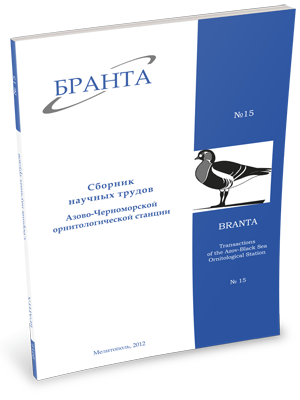
Transactions
of the Azov-Black Sea Ornithological Station



Characteristics of space-time distribution of the Rook (Corvus frugilesus) related to the territory of Ukraine
A. M. Poluda, S. V. Tsukanova
A pattern of seasonal migrations of the Rook is presented basing on literary sources and own observations of migratory movements of the species in different regions of Ukraine conducted since the 1970s. In particular, there is given information about timing of spring and autumn migration of rooks, directions of their movements, quantitative characteristics of migration. Analysis of 448 recoveries of ringed rooks revealed some regularities of space-time distribution of these birds in different periods of their annual cycle. Almost the whole data set (97.1%) relates to the birds ringed in 1948-1990. After juveniles left their nests (2nd half of May) the range of their dispersal flights is increasing with every month: in June recoveries were received from the distance of 36 km (15-69 km); in July – 82 (38-109), in August – 79 (31-207), in September – 85 km (11-174 km). At the same time, there were no dominant directions of movements. Autumn migration of rooks starts in October, for birds from northern areas – in the 1st decade (there are recoveries from the distance up to 900 km in this period), from southern areas – in the 3d decade (recoveries from the distance 255-610 km). Migratory movements continue during November – “Ukrainian” rooks from southern areas gave recoveries with an average distance of 529 km (784 km in December). This is evidence that migratory movements finish, more likely, in the first half of December.
A majority of rooks from the Ukrainian population winter outside Ukraine, as a rule, in countries of Central and Southern Europe. And birds from northern, central and southern areas winter in different regions: birds from the first two areas mainly winter in Central Europe, and birds from South Ukraine – in Southern Europe (mainly in the Balkans). Mean azimuth of movements of “northern” birds” (n=44) makes up 257 ± 1.3°, mean distance is 1,182 ± 58 km. Rooks from southern areas (n=94) moved as far as 746 ± 20.4 km, with average azimuth 237±1.1°. These data demonstrate that rooks from northern Ukrainian populations have more western direction of autumn migration and longer distance of flight to their wintering grounds. The reliability of differences in distance of movements for rooks from northern and southern part of Ukraine is very high (p < 0.001).
A part of Ukrainian rooks winter in Ukraine – of 169 winter recoveries relating to birds of local groups, 31 recoveries (18.3%) were received from birds which wintered in Ukraine. It was revealed that juvenile rooks, in case of close wintering, move much further from their natal area than those which were found during next winterings: 141±30.2 and 96±19.2 (difference is statistically unreliable). Another trend is also recorded: in southern areas percentage of wintering juveniles from Ukrainian breeding groups is substantially higher than that of adults. A reverse trend is recorded in northern areas where adults dominate among local birds.
The territory of Ukraine is a wintering area of rooks. It holds a part of Ukrainian birds in a cold period of the year but the rooks, arriving from eastern regions, dominate. These birds nested or hatched in such regions of Russia as Astrakhan, Kaluga, Kursk, Perm, Ryazan, Samara, Saratov, Tambov, Ulyanovsk and Chelyabinsk Regions, and in the republics of Bashkiria, Mordovia and Tatarstan. There are two recoveries from the birds ringed in Kazakhstan. Mean azimuth of movements of these rooks is 254±1.9°, mean distance– 1,245 ± 71.8 km, minimal distance of flight – 126 km, and maximal – 2,484 km. Analysis of recoveries of ringed rooks has shown that over the last 80 years the rooks changed their wintering grounds and, consequently, shortened the migration route. Thus, in the 1930s-1950s a part of Ukrainian rooks wintered in France and Italy, but already in the 1960s-1980s there were no records of our birds in these countries. We link this with general climate warming and also with increase of agricultural activity in countries of Central Europe which created favourable conditions for rooks wintering in this region. In the recent 20 years (since the early 1990s) it was recorded reduction in the number of migratory rooks, and timing of migration shifted for 3-4 weeks: to later dates in autumn (to November), and to earlier dates in spring (February-early March). Percentage of rooks which do not leave their nesting (natal) area for winter has increased both in adult and juvenile birds.
Read the paper in a PDF file